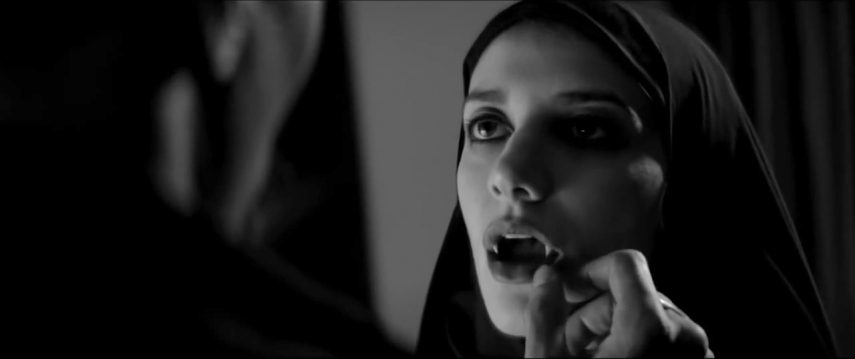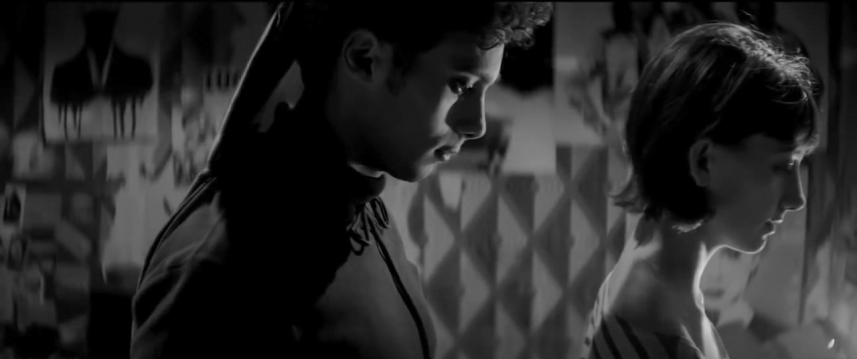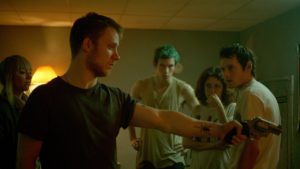“Are you a good boy? Answer me.”
These are the first words spoken by the title character known simply as The Girl (Sheila Vand), questioning a young boy. That the Girl says this around half an hour into the film shows that she doesn’t really say very much. Nor does she utter a single word to any of her victims. Why should she? They’re going to die anyway.
The title may paint a picture of a girl in danger, but here it is instead the Girl that is doing the stalking and killing. It turns out that the Girl is a vampire, one who is lonely, bored and appears to be just passing the time by killing a few people in the desolate Bad City. The first time we see her devour a victim, she takes their jewellery and goes through their CD collection. These seem to be the only things of interest to the Girl. At her home, she has a table littered with jewellery and watches, and walls adorned with posters of Michael Jackson, The Bee Gees and Madonna. When she isn’t walking home she gets around the city via skateboard.
Labelled as an Iranian vampire western, A Girl Walks Home Alone at Night is the feature film debut from writer/director Ana Lily Amirpour, expanding on one of her short films. Shot in sumptuous black and white with the characters speaking Farsi, it was filmed in California and partially financed through Indiegogo, with Elijah Wood as one of the executive producers. Light on thrills and scares it is less a horror and more a strange love story that just so happens to involve a vampire.
The James Dean-esque Arash (Arash Marandi) is looking after his drug-addicted father Hossein (Marshall Manesh), who is struggling to pay off a huge debt to the local drug-dealing pimp Saeed (Dominic Rains, decked out with a large necklace and plenty of tattoos). Realising that Hossein is unable to pay him, Saeed helps himself to Arash’s vintage car (a 1957 Ford Thunderbird) as payment and later meets with prostitute Atti (Mozhan Marnò), taking all of the money she has earned. Amid this is the Girl, whom everyone encounters at some point.
The Girl meets Arash after he finds himself lost when leaving a costume party. Dressed up as Dracula, he holds her hand and tells her that she’s cold. Their unusual conversation leads the Girl to take him home, where she puts on a record: Death by White Lies. The lyrics speak for the both of them. The excellent soundtrack (which will later be released on vinyl by Death Waltz Recording) also includes Iranian rock from Radio Tehran and Kiosk, while the band Federale bring their Ennio Morricone inspired sound to the film.
As the Girl, Sheila Vand lets her body do most of the talking. Amazingly, her face remains largely devoid of any emotion, showing just how bored the Girl must be (for example: at one point she is asked if she would like a line of coke, but doesn’t respond at all). We’re never quite sure what the Girl desires, but then, being immortal, if you’ve tried everything, what else is there left? The striped top and flowing chador combo makes Vand a captivating presence when onscreen. That her interaction with people often begins by watching and following them also makes her incredibly creepy.
Marandi’s Arash is also a loner, with an appearance that suggests he’s been heavily influenced by American culture (the hair, the jacket, the car, the hamburgers). After a failed attempt to hook up with someone at a party, it’s clear that he is looking for love. Wanting to know more about the Girl, he later meets her at a power plant for something that resembles a date, which proves to be as funny as it is moving: the Girl allows him to pierce her ears so that she can wear a pair of earrings.
Because of the thin narrative, the film only ever skims the surface on the lives of its characters, most of whom are essentially archetypes – a junkie, a prostitute, a pimp and a street urchin (Milad Eghbali). Instead, the focus is on visual style and the portrayal of emotions. Amirpour doesn’t rush things and often leaves the camera to linger on the characters, waiting for them to make their move, sometimes looking a little unsure as to what that will be. Amirpour has also spoken about being a fan of graphic novels, which would explain the film’s striking look, with cinematographer Lyle Vincent framing some scenes like a panel taken straight out of a comic book. Some shots in here you could probably freeze, print, frame and hang on your wall. There is also a six-part graphic novel Amirpour worked on alongside the film, which features other stories about the Girl.
Whereas the Girl asks a child whether he’s been good, she herself tells Arash straight out, “I’ve done bad things. I’m bad.” In fact, almost every character we see in Bad City lives up to its name, doing things that could very well land them in prison – that is, if the city had one. There are no sirens in the background and deaths go unreported. Very early on, we see numerous bodies left piled up in a ditch, a sight that fazes no one who walks past it. That there are a lot of dead bodies suggests that maybe the Girl has already gone through most of the inhabitants of Bad City (could that be why it’s so empty?). By stalking bad men that have been using and abusing women, it can be argued that the film presents a feminist vampire righting wrongs, yet one of her (likely innocent) victims just happens to be in the wrong place at the wrong time.
The slow pace keeps the story stuck in first gear, but mixed with the striking visuals and soundtrack the end result is refreshingly unique. There simply isn’t anything like it. Odd, mesmerising and unpredictable, A Girl Walks Home Alone at Night suitably twists conventions rather than following them, and for that reason it deserves some high respect.
Originally published on MCM Buzz on 31 October 2014.





